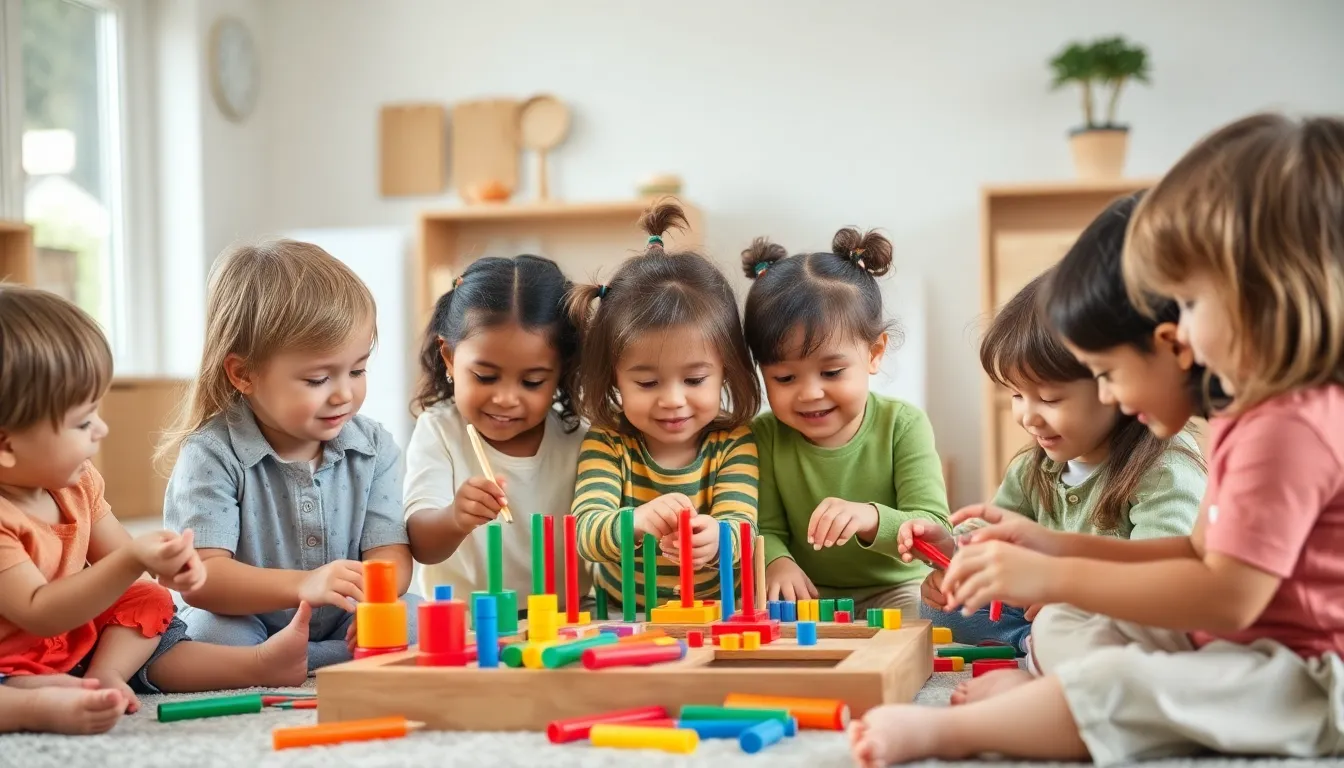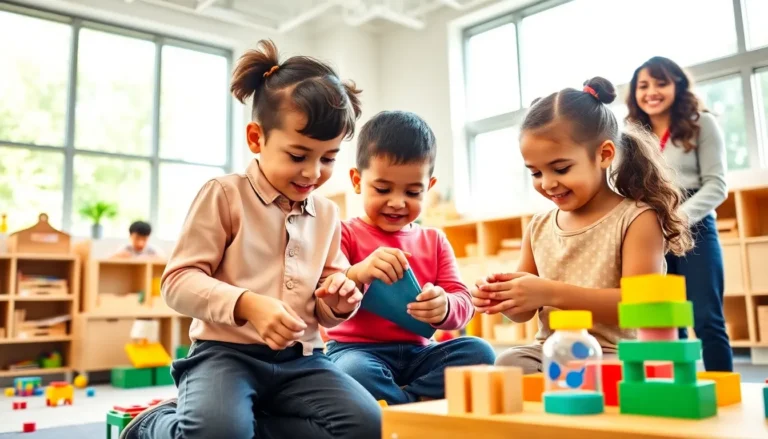When it comes to sparking a child’s curiosity, Montessori materials are like the secret sauce of education. These carefully crafted tools don’t just sit on a shelf collecting dust; they invite kids to dive into hands-on learning adventures. From colorful counting beads to beautifully designed puzzles, each material is a ticket to a world where learning feels like play—because who said education can’t be fun?
Table of Contents
ToggleOverview of Montessori Materials
Montessori materials consist of a wide variety of resources created to support children’s natural learning processes. These tools encourage exploration, discovery, and active participation in education. Various types focus on sensory experiences, motor skills, and cognitive development.
Practical life materials train kids in everyday tasks. Activities like pouring, spooning, and washing enhance fine motor skills while promoting independence. Sensorial materials engage the senses, helping children differentiate colors, shapes, and textures. Examples include color tablets and sound boxes.
Mathematics materials lay a strong foundation for numerical understanding. Tools like number rods and golden beads offer tactile experiences that simplify abstract concepts. Language materials foster literacy skills through various activities centered around phonetics, vocabulary, and grammar.
Cultural materials broaden children’s perspectives on the world. These expose kids to geography, history, and science through interactive tools, such as map puzzles and timeline cards. Art materials stimulate creativity, enabling self-expression while teaching about different artistic techniques.
Teachers play a crucial role in utilizing these materials effectively. Guidance from educators ensures that children engage with materials meaningfully. Observing children’s interests allows instructors to introduce appropriate resources, aligning with individual learning paths.
Montessori materials transform classrooms into rich learning environments. Hands-on tools stimulate curiosity and enthusiasm, making education a joyful journey. Each carefully designed resource targets specific developmental needs, promoting holistic growth and lifelong learning habits.
Types of Montessori Materials

Montessori materials encompass various categories designed to foster children’s learning. Each type serves a distinct purpose, enhancing different aspects of development.
Practical Life Materials
Practical life materials include tools that promote independence and fine motor skills. Activities such as pouring, cutting, and buttoning cultivate everyday skills. Children practice these tasks through hands-on experiences, thereby gaining confidence. Tasks mimic real-life scenarios, making learning applicable and enjoyable. As they master these skills, children develop focus and concentration.
Sensorial Materials
Sensorial materials focus on refining children’s sensory perceptions. These resources engage various senses, such as touch, sight, and hearing, allowing children to explore their environment. Items like color tablets and sound boxes help distinguish between different stimuli. Children learn to identify, compare, and contrast various elements, strengthening cognitive abilities. Engaging with these materials nurtures curiosity and promotes observation skills.
Mathematical Materials
Mathematical materials introduce foundational math concepts through tactile experiences. Number rods and golden beads simplify operations like addition and subtraction. Children manipulate these materials, which makes abstract concepts tangible. They understand quantities and relationships, building a strong mathematical foundation. Additionally, these resources encourage exploration and problem-solving skills.
Language Materials
Language materials engage children in building literacy skills through interactive activities. Tools like moveable alphabets and phonetic objects support reading and writing development. Children easily grasp phonetic sounds and word formation through hands-on play. This exploration fosters vocabulary expansion and communication skills. Engaging with these materials lays the groundwork for successful literacy experiences.
Benefits of Using Montessori Materials
Montessori materials contribute significantly to a child’s overall development. These tools offer unique advantages that foster growth in various areas.
Promoting Independence
Montessori materials empower children to take charge of their learning. Practical life activities teach essential skills, allowing kids to perform tasks independently. As they engage with these materials, they develop confidence and a sense of ownership over their learning experience. This independence leads to enhanced decision-making skills and self-discipline. Children learn to manage their time and choose activities that resonate with their interests. In turn, this autonomy boosts their motivation and encourages a love for learning, making education a fulfilling journey rather than a mandated obligation.
Enhancing Learning Through Play
Play serves as a natural method for children to explore and learn. Montessori materials encourage playful interactions that stimulate curiosity and creativity. Engaging with hands-on activities makes complex concepts more accessible and enjoyable. Children develop critical thinking and problem-solving skills without the pressure of traditional learning environments. Sensory-rich experiences through materials promote exploration and discovery, reinforcing the connection between play and academic skills. Learning becomes a joyful process, blending playtime with educational growth, setting the foundation for lifelong learning habits.
Selecting the Right Montessori Materials
Choosing the appropriate Montessori materials is essential for fostering effective learning experiences. Factors such as age, developmental stage, and individual interests greatly influence selection. High-quality materials often invite engagement and deepen exploration.
It’s crucial to focus on practical life materials first. These items build independence and enhance fine motor skills through everyday tasks. Sensory materials should also receive attention, as they refine sensory perceptions and cognitive development.
Mathematical materials come next, such as number rods and golden beads, which simplify abstract concepts via tactile experiences. Language materials promote literacy skills and encourage children to interact with phonetics and vocabulary through engaging activities. Cultural materials introduce diverse perspectives on geography, history, and science, enriching the educational environment.
Art materials hold valuable significance as well, as they stimulate creativity and allow for self-expression. Prioritizing these resources ensures a comprehensive learning toolbox that caters to various developmental needs.
It’s equally important to involve teachers in this process. Their guidance aligns materials with children’s individual learning paths, fostering meaningful engagement. Frequent evaluation of children’s interests and progress can guide further material selection, ensuring ongoing adjustment to their evolving needs.
Selecting the right Montessori materials supports holistic growth by promoting exploration, independence, and engagement in education. This strategic approach transforms learning into a joyful adventure, setting a strong foundation for lifelong learning habits.
Montessori materials play a vital role in shaping a child’s educational journey. By encouraging exploration and hands-on learning, these tools not only make education enjoyable but also foster independence and confidence. Each material serves a unique purpose, supporting various developmental areas and promoting holistic growth.
The thoughtful selection of Montessori resources, guided by teachers, ensures that children engage meaningfully with their learning experiences. This strategic approach aligns with individual needs, enhancing the overall effectiveness of the Montessori method. Ultimately, incorporating these materials transforms learning into a joyful adventure, laying the groundwork for a lifetime of curiosity and academic success.




